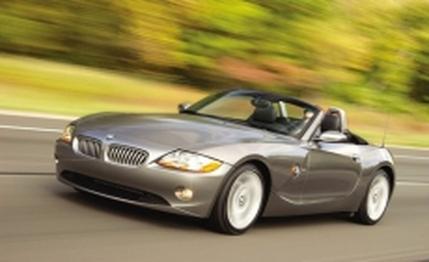
 Road Test
Road Test
With the Z4 roadster, BMW has created a car so modern that it has engine music piped into the cabin, like Muzak for auto enthusiasts. But more on that later. First, to understand this odd-looking roadster, one must look at the car it replaces, the Z3.
The year was 1995 B.G.R. ("before German roadsters"), and the roadster market was dark and without form. Only the Mazda Miata existed, and it was good. A digitally remastered version of the Lotus Elan, the Miata was cheap, not very fast, a hoot to drive, wildly popular.
So when BMW entered the market for 1996, it was no surprise that its Z3 was a retro-styled four-cylinder runabout with a manual fabric roof. It was made of bits from the old parts shelf, including a 3-series rear suspension that was already one generation old when it appeared on the Z3. It was clothed in sheetmetal firmly rooted in the Industrial Age, calling to mind vintage streamlined locomotives. If you're of a Freudian bent, it may have summoned to mind the phallic nose of the cartoonish cigarette-selling aide, Joe Camel.
Predating the Mercedes SLK and Porsche Boxster by more than a year, the Z3's combination of a relatively low price and retro looks proved a good recipe for sales.
Once the slick Mercedes SLK and the brilliant Porsche Boxster arrived on the scene, the Z3 never won a comparison test. Those competitors weren't cheap, but they were modern, sophisticated expressions of the roadster concept, leaving the Z3 to look like the poor stepchild of the German-roadster market.
The 2003 Z4 has lost the retro look of the Z3, although the long-nose, short-deck proportions remain. It could be considered modern, if that means complicated and odd, because all the lines, creases, bumps, and polyps applied on top of that basic form - and there's a lot applied on top - are, um, modern. BMW believes designers should point the way to the future, not mimic current tastes. We don't think it's pretty, but time will tell if the Z4 is one day seen as groundbreaking in the manner of Frank Lloyd Wright's Guggenheim Museum or dismissed as period tackiness à la Mr. T's mohawk.
What we know for sure after our drives in the south of Portugal and in the south of Michigan is that the Z4 is a premium sports car in a way the Z3 never was.
This time BMW went to its current parts shelf. The Z4 uses the same basic suspension found in the latest 3-series, tuned for sports-car duty. There are struts up front and an aluminum-intensive multilink arrangement under the Z4's bumpy rump. It's the rear suspension that makes the difference here. Gone is the nervous tail that became flustered and jittery at the touch of a midcorner bump - and gave up its grip entirely when you got off the throttle in turns. That distinctly vintage vice (one in which the Boxster has never indulged) is replaced by a rear end that positively refuses to step out uninvited. In fact, if there's a fault to be found with the Z4's handling, it's the opposite: The rear sticks longer than necessary (read "understeer"). Newly nimble, the Z4 ensures confidence with its stiff structure, modern suspension, and widened track, but there's no mistaking this for anything but a front-engined car. Push hard, and the front tires give up as weight shifts to the outside front corner of the car. But allied with the world's most rapid and linear throttle response, you can easily transfer power rearward with one healthy application of the gas pedal. The car tightens its line in the corner with an ease that implies it was just joking about that understeer thing. The Z4 boasts 0.91 g of stick at the skidpad. The best we ever managed in the Z3 was 0.88 g, and that came from the souped-up M roadster. The Z4 grips the road as surely as a Corvette or a Porsche Boxster S.